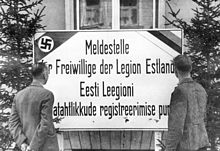
The Waffen-SS was the combat branch of the Nazi Party's paramilitary Schutzstaffel (SS) organisation. Its formations included men from Nazi Germany, along with volunteers and conscripts from both occupied and unoccupied lands. It was disbanded in May 1945.

Gottlob Christian Berger was a senior German Nazi official who held the rank of SS-Obergruppenführer und General der Waffen-SS and was the chief of the SS Main Office responsible for Schutzstaffel (SS) recruiting during World War II. At the post-war Nuremberg trials, the Waffen-SS – within which Berger was a senior officer – was declared to be a criminal organisation due to its major involvement in war crimes and crimes against humanity. Berger was convicted as a war criminal and spent six and a half years in prison.

Hiwi, the German abbreviation of the word Hilfswilliger or, in English, auxiliary volunteer, designated, during World War II, a member of different kinds of voluntary auxiliary forces made up of recruits indigenous to the territories of Eastern Europe occupied by Nazi Germany. Adolf Hitler reluctantly agreed to allow recruitment of Soviet citizens in the Rear Areas during Operation Barbarossa. In a short period of time, many of them were moved to combat units.

The 11th SS Volunteer Panzergrenadier Division Nordland was a Waffen-SS division primarily raised with Germans and ethnic Germans from Romania, but also foreign volunteers from Northern and Western Europe. It saw action, as part of Army Group North, in the Independent State of Croatia and on the Eastern Front during World War II.
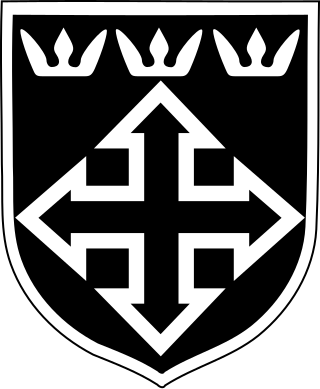
The 26th Waffen Grenadier Division of the SS , was a short-lived infantry division of the Waffen-SS, an armed branch of the German Nazi Party that served alongside but was never formally part of the Wehrmacht during World War II. Established in November 1944 following the German overthrow of the Hungarian regime of Miklós Horthy, it was never properly formed, trained, or equipped, and after being evacuated from its training camp in the face of the advancing Soviet Red Army, it surrendered to the United States Army in Austria in May 1945.

Ostlegionen, Ost-Bataillone, Osttruppen, and Osteinheiten were units in the Army of Nazi Germany during World War II made up of personnel from the Soviet Union. They were a large part of the Wehrmacht foreign volunteers and conscripts.
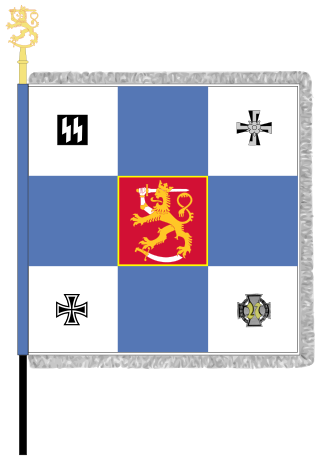
From 1941 to 1943, 1,408 Finns volunteered for service on the Eastern Front of World War II in the Waffen-SS, in units of the SS Division Wiking. Most of these volunteers served as motorized infantry in the Finnish Volunteer Battalion of the Waffen-SS. The unit was disbanded in mid-1943 as the volunteers' two-year commitment had expired and the Finnish government was unwilling to allow more men to volunteer. In 1944-1945 a company sized unit of Finnish defectors recruited to the SS continued fighting alongside Germany.

The 20th Waffen Grenadier Division of the SS was a foreign infantry division of the Waffen-SS that served alongside but was never formally part of the Wehrmacht during World War II. According to some sources, the division was under Reichsführer-SS Heinrich Himmler's overall command but was not an integral part of the Schutzstaffel (SS). It was officially activated on 24 January 1944, and many of its soldiers had been members of the Estonian Legion and/or the 3rd Estonian SS Volunteer Brigade, which had been fighting as part of German forces since August 1942 and October 1943 respectively. Both of the preceding formations drew their personnel from German-occupied Estonia. Shortly after its official activation, widespread conscription within Estonia was announced by the German occupying authorities. The division was formed in Estonia around a cadre comprising the 3rd Estonian SS Volunteer Brigade, and was initially known as the 20th Estonian SS Volunteer Division.
Azerbaijani SS volunteer formations were recruited from prisoners of war, mainly from the Soviet Union and the countries annexed by it after 1939. Nazi Germany organised them to fight against the Soviet Union.

The Latvian Legion was a formation of the Nazi German Waffen-SS during World War II. Created in 1943, it consisted primarily of ethnic Latvian personnel. The legion consisted of two divisions of the Waffen-SS: the 15th Waffen Grenadier Division of the SS, and the 19th Waffen Grenadier Division of the SS. The 15th Division was administratively subordinated to the VI SS Corps, but operationally it was in reserve or at the disposal of the XXXXIII Army Corps, 16th Army, Army Group North. The 19th Division held out in the Courland Pocket until May 1945, the close of World War II, when it was among the last of Nazi Germany's forces to surrender.
HIAG was a lobby group and a denialist veterans' organisation founded by former high-ranking Waffen-SS personnel in West Germany in 1951. Its main objective was to achieve legal, economic, and historical rehabilitation of the Waffen-SS.

The Azerbaijani Legion was one of the foreign units of the Wehrmacht. It was formed in December 1941 on the Eastern Front as the Kaukasische-Mohammedanische Legion and was re-designated 1942 into two separate legions, the North Caucasian legion and the Azerbaijani legion. It was made up mainly of former Azerbaijani POW volunteers but also volunteers from other peoples in the area. It was part of the Ostlegionen. It was used to form the 162nd (Turkistan) Infanterie-Division of the Wehrmacht in 1943. similar to other Ostlegionen, it was organised to replenish the dwindling German manpower on the Eastern front and to "save the German blood at the front"

The 24th Waffen Mountain Division of the SS "Karstjäger" was a German mountain infantry division of the Waffen-SS, the armed wing of the German Nazi Party that served alongside, but was never formally part of, the Wehrmacht during World War II. At the post-war Nuremberg trials, the Waffen-SS was declared to be a criminal organisation due to its major involvement in war crimes and crimes against humanity. Named Karstjäger, the formation was one of the 38 divisions fielded by the Waffen-SS. Formed on 18 July 1944 from the SS Volunteer Karstwehr Battalion, its nominal strength was never more than theoretical and the division was soon reduced to the Waffen Mountain (Karstjäger) Brigade of the SS. Throughout its existence as a battalion, division and brigade, it was primarily involved in fighting partisans in the Karst Plateau on the frontiers of Yugoslavia, Italy, and Austria; the mountainous terrain required specialised mountain troops and equipment.
The Belarusian Home Defence, or Belarusian Home Guard were collaborationist volunteer battalions formed by the Belarusian Central Council (1943–1944), a pro-Nazi Belarusian self-government within Reichskommissariat Ostland during World War II. The BKA operated from February 23, 1944 to April 28, 1945. The 20,000 strong Belarusian Home Defence Force was formed under the leadership of Commissioner-General Curt von Gottberg, with logistical help from the German 36th Waffen Grenadier Division of the SS known as the "Poachers' Brigade" commanded by Oskar Dirlewanger.

The Wehrmacht were the unified armed forces of Nazi Germany from 1935 to 1945. It consisted of the Heer (army), the Kriegsmarine (navy) and the Luftwaffe. The designation "Wehrmacht" replaced the previously used term Reichswehr and was the manifestation of the Nazi regime's efforts to rearm Germany to a greater extent than the Treaty of Versailles permitted.

During World War II, the Waffen-SS recruited significant numbers of non-Germans, both as volunteers and conscripts. In total some 500,000 non-Germans and ethnic Germans from outside Germany, mostly from German-occupied Europe, were recruited between 1940 and 1945. The units were under the control of the SS Führungshauptamt beneath Reichsführer-SS Heinrich Himmler. Upon mobilisation, the units' tactical control was given to the Oberkommando der Wehrmacht.
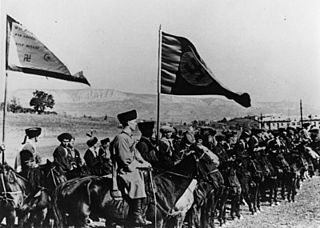
A large number of Soviet citizens of various ethnicities collaborated with Nazi Germany during World War II. It is estimated that the number of Soviet collaborators with the Nazi German military was around 1 million.
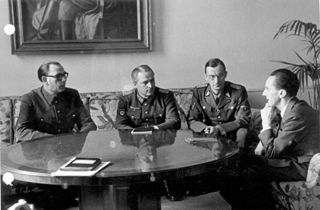
Among the approximately one million foreign volunteers and conscripts who served in the Wehrmacht during World War II were ethnic Belgians, Czechs, Dutch, Finns, Danes, French, Hungarians, Norwegians, Poles, Portuguese, Swedes, Swiss along with people from Great Britain, Ireland, Estonia, Latvia, Lithuania, and the Balkans. At least 47,000 Spaniards served in the Blue Division.
The Waffen-SS, the combat branch of the paramilitary SS organisation of Nazi Germany, is often portrayed uncritically or admiringly in popular culture.
Ernst Klink was a German military historian who specialised in Nazi Germany and World War II. He was a long-term employee at the Military History Research Office (MGFA). As a contributor to the seminal work Germany and the Second World War from MGFA, Klink was the first to identify the independent planning by the German Army High Command for Operation Barbarossa.

